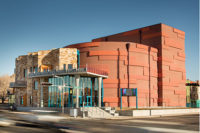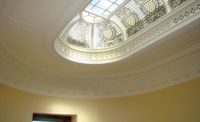
The term “stucco” for exterior plaster is inaccurate. In European countries, stucco refers to interior ornamental plaster. Proper terminology is actually “render” or in other places “parget.” However, somewhere along the development line of our country, someone called it stucco and it stuck (pardon the pun). Due to the abundance of trees, stucco was generally not used on most residential structures. If it was, it was applied as protection over a poorer quality material more prone to moisture. This could be rubble stone, poorly fired or porous brick and in many cases sandstone.
Actually what we now know as stucco wasn’t necessarily the same product we have become accustomed to. Although naturally occurring cement (Roman Cement or Pozzolana) had been discovered in upstate New York in 1817, it was not widely used as the cementitious binder in stucco applications. The late 19th century saw some major changes in the plastering industry. For stucco, 1874 was a milestone year because the first Portland cement manufacturing plant opened in the United States. Up until that time and for a good while afterwards, lime putty was the principal cementitious binder in both interior and exterior plastering applications. On occasion, naturally occurring cements may have been used to quicken the set of lime plaster but for the most part hydraulic cements were hard to come by and generally cost-prohibitive.

Up until the middle of the 18th century, framing mimicked simple European post and beam construction. Production sawmills that began sizing and milling operations of dimensional lumber led us to framing techniques that we know today. An abundance of old growth lumber made it possible to frame a structure with long 2x4 stud lumber from the foundation of the house to the rafters. We know this method as “Balloon Framing,” which gave way to modular elements of building the floors first and setting the wall structure on top or “Western Platform Framing” in the 1930s.
The studs were tied together by something called a “ribband” that was mortised into the studs at second floor lines to accommodate the floor joists. This minimized the deflection of the long framing materials but required solid blocking to mitigate the risk of the “chimney effect” where fire spread quickly through the open columns of framing.
Although composite sheathing (plywood) was unheard of, builders understood the structural value of bracing a wall with dimensional boards (sheathing), by fastening them either perpendicular or diagonal to the studs. All that wood sheathing also managed the dead loads of the structure and kept the deflection of the balloon framing in check. From excavation to completion, it was not unusual for a house to be completed in well over a year’s time. This drawn-out time frame afforded all that lumber to dry completely, which mitigated cross grain shrinkage of the sheathing that would have translated into cracks in the stucco.

The first use of what was referred to as “waterproof” paper can be traced back to 1844. The concept was taken from ship building construction where pine pitch was used in hull joinery. Pine pitch was impregnated into the production process of making paper and used primarily for roofing buildings.1 Over time, this “waterproof” paper making process included asphalt and cotton fibers that were pulped into the paper making in what we now refer to as “rag felt.” Much like the felt we see on a billiard table, rag felt was more fiber open to accommodate more asphalt, making it more water resistant. The inherent problems with these products were that because they had more organic content, they were much more prone to decomposition, dimensional instability, splitting, cracking and blistering. The term “waterproof” is a bit misleading. The bitumen is what makes them resistant to moisture; however, the dry felt also would absorb water and pass water in its gaseous state (vapor).
FURRING AND LATHING
Typically, vertical 1-inch-by-2-inch furring was attached 12 inches on center over the waterproof paper and sheathing. Wood laths were then attached perpendicular to the furring and parallel to one another. Laths were spaced apart approximately 1/4 to 3/8 inch to provide a mechanical key for the stucco to engage the laths, and roll and clinch around them as it set up.
Before the stucco was applied, the dry wooden laths were wetted down to neutralize them from sucking out too much of the moisture from the stucco. Although metal lath was available in the early days of the 20th century, it is generally accepted that the use of wood lath continued right up to World War II. However, in 1920 the American Concrete Institute concluded that wood lath was not appropriate for Portland cement plaster applications.2 That determination was derived from test panels that exhibited large cracks. That conclusion, although slow to reach the masses, probably hastened wood laths demise in stucco applications.
MODERN IMPLICATIONS
This type of construction managed moisture by maintaining a state of equilibrium where moisture events were mitigated by the passage of heat and air through the wall. Certainly the lack of any type of vapor retarder, insulation and all of the gaps built in between the sheathing boards helped the walls dry out quite effectively in those moisture events.
What was not probably realized in this process of application is that the 1x furring also provided an unencumbered drainage plane behind the stucco. This is not all that much different than some of the rainscreen products that have popped up in recent years on newer stucco construction. Purposeful or not, furring the stucco out beyond the plane of the sheathing decouples it from the waterproof paper. This prevents capillarity continuity, provides a clear and faster drainage path for incidental moisture and also aids in drying the wall.
It was purely unintentional, but what seems interesting beyond the scope of this application process is the air space that resulted from using the 1x furring. In a discussion with a local engineer, a nominal 1/2 to 1 inch space would be appropriate behind new stucco applications to provide a net convective unidirectional air flow to essentially dry out the assembly. This type of installation also requires vents at both the bottom and the top of the drainage plane for ventilation to take place. Vents were obviously not on the mind of the old timers who concocted this assembly but you have to admit that the airspace probably mitigated the balance of heat and air necessary to dry things out.
FOOTNOTES:
1 “Weather Resistive Barriers and Flexible Flashings,” AAMA Western Regional Meeting, 2003, Thomas K. Butt, FAIA2 A Brief History of the Development of Stucco, Jamie Farny, Portland Cement Association




Report Abusive Comment